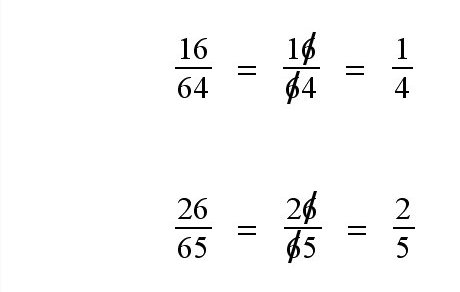Saw this on Facebook and thought about how many people would potentially believe this just from seeing these few examples. It was a blog post on StumbleUpon suitably named "Reductio Ad Absurdum", which is the Latin name for a form of argument trying to prove that a statement is true by showing that it isn't always false. Confusing, I know.
http://www.stumbleupon.com/su/98nFXu/:14UyCe2wF:d4iWQ6c./www.futilitycloset.com/2007/02/02/reductio-ad-absurdum/
http://www.stumbleupon.com/su/98nFXu/:14UyCe2wF:d4iWQ6c./www.futilitycloset.com/2007/02/02/reductio-ad-absurdum/
These were the examples from the blog post. At first glance, this makes total sense. It could really confuse a bunch of elementary students!
But further looking at this, you begin to realize that these are some of the very few instances where this applies. Obviously, the fraction has to have the same number in the two diagonals (in the case of the first one, both 9s were the ones that could be cancelled out). In fact, through all of my attempts I have not found any other numbers that it works for. But it is amusing to think that someone would probably take this and just believe it based on a few examples. Doesn't work every time, folks! Don't believe everything you see on the internet.


 RSS Feed
RSS Feed